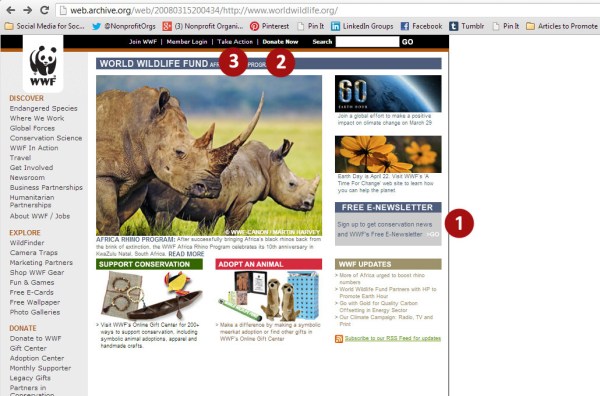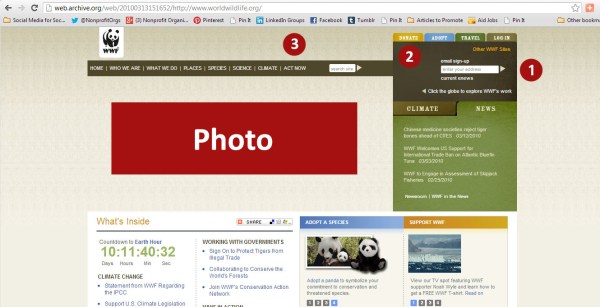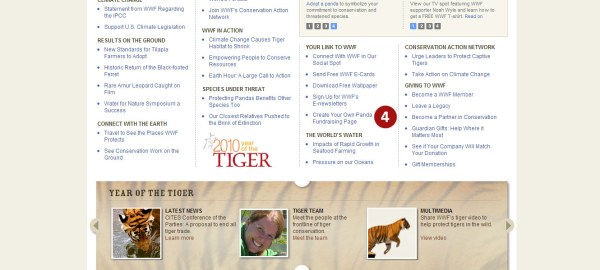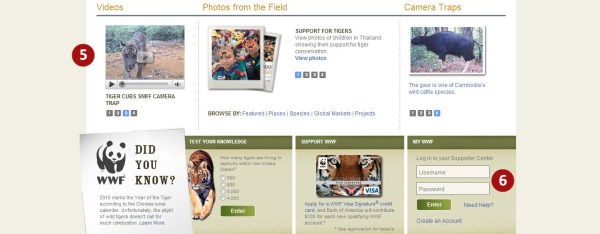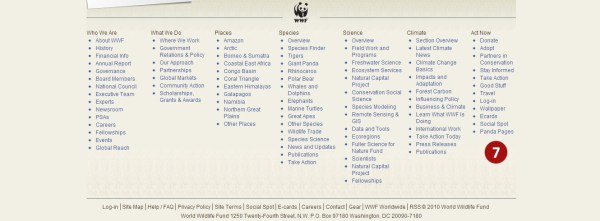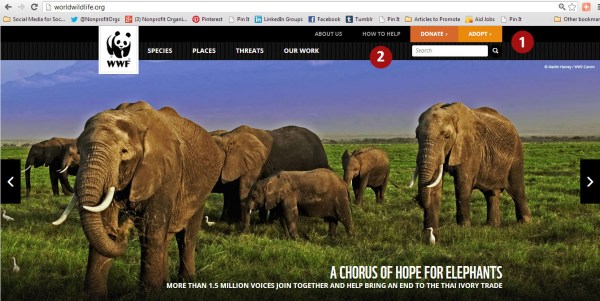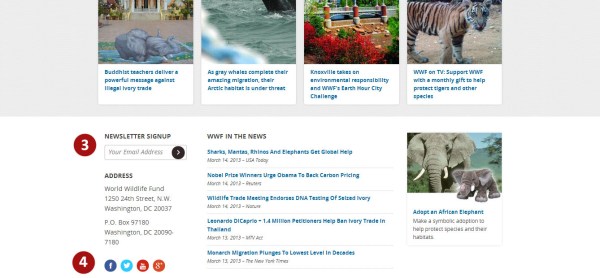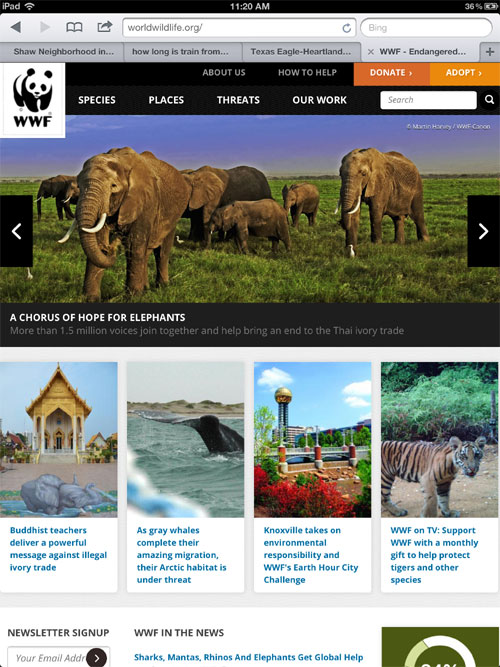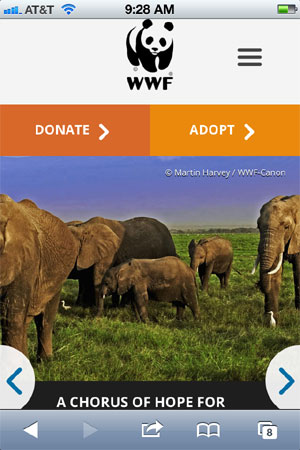 Nonprofit website design and online fundraising have dramatically changed in recent years due to the rapid rise of social media and mobile communications. Using the Wayback Machine – a website that allows you to view archived screenshots of your website all the way back to 1996, below is an exploration of how the World Wildlife Fund’s website and online fundraising campaigns have evolved since 2008. One of my favorite nonprofits to study, nonprofits would be wise to subscribe, follow, and like the World Wildlife Fund and learn from their commitment to early adoption and investing resources in building a powerful online brand.
Nonprofit website design and online fundraising have dramatically changed in recent years due to the rapid rise of social media and mobile communications. Using the Wayback Machine – a website that allows you to view archived screenshots of your website all the way back to 1996, below is an exploration of how the World Wildlife Fund’s website and online fundraising campaigns have evolved since 2008. One of my favorite nonprofits to study, nonprofits would be wise to subscribe, follow, and like the World Wildlife Fund and learn from their commitment to early adoption and investing resources in building a powerful online brand.
World Wildlife Fund Website :: March 15, 2008
View: worldwildlifefund.org Archive 3/15/08
In 2008 (and years previous) websites were aligned left and more narrow since computer screens were smaller. Much of a nonprofit’s website traffic came from search engines thus a large quantity of content was placed on the home page. In fact, to allow for maximum content, the WWF used a tiny 8 point font in their 2008 home page design. Today, this font size and large quantity of content would visually overwhelm supporters and donors. It’s also worth noting that social media, not even blogging, is not yet integrated into their website. In 2008, the WWF was on Myspace and likely utilizing a Facebook Group and YouTube Channel, but those tools had not yet become integrated into their website design.
1. e-Newsletter :: By 2008 nonprofits were beginning to understand and harness the power of e-mail marketing for online fundraising, branding, and cause awareness. Many nonprofits had been experimenting since the late 90’s to varying degrees of success, but by 2008 e-newsletters had become one of the most important online outreach and fundraising tools for nonprofits. What’s interesting to note is that their prominently featured e-newsletter pitch highlights that the e-newsletter is free – a clear indicator that e-mail marketing was still relatively cutting edge in 2008.
2. Donate Now Technology :: Featured in the navigation bar is a “Donate Now” link. The technology to accept donations online was launched in the late 90’s, but it wasn’t until 2008 that nonprofits began to experience significant dollars raised online primarily thanks to the rise of e-newsletters and social media.
3. Online Advocacy :: Another technology that launched in the late 90’s was the ability to sign online petitions and send emails to members of Congress. These new tools helped nonprofits create change and awareness, but online advocacy also enabled nonprofits to significantly grow their database of contacts for both print and online funding appeals.
Summary: By 2008 the strategy of using e-mail to drive traffic to a nonprofit’s website to create awareness to convert supporters into donors and online activists was revealing itself to be a powerful combination.
World Wildlife Fund :: March 15, 2010
View: worldwildlifefund.org Archive 3/15/10
By 2010 the World Wildlife Fund had launched a much larger, longer website with more color, larger photos, and a larger font. The website design was wider and centered to accommodate larger computers and laptops. In 2010 social media use was exploding in the nonprofit sector and the World Wildlife Fund was beginning to integrate social media into their website, but the foundation of their online fundraising and awareness campaigns – their e-newsletter, “Donate Now” button, and online action network – were still the most prominently featured tools featured on their home page. That said, the volume of content on their home page is much higher than it was in 2008. At this time online supporters were not yet with grappling information overload on the level that they are today and it was still a best practice to feature as much content as possible.
1. e-Newsletter :: The e-newsletter subscriber functionality is now prominently feature in the upper right hand corner of the home page and also on every page of the website.
2. Donate Now Technology :: The “Donate Now” link has evolved into a yellow “Donate” button. The color makes it stand out and similar to the e-newsletter pitch, the “Donate” button is visible on every page of the website.
3. Online Advocacy :: The online action network is now featured under a catch-all “Act Now” link. By 2010 the number of new tools available to nonprofits to experiment with was exploding and this gave rise to the need for a page on a nonprofit’s website that listed all the ways that a support can act now, or get involved, or take action.
4. Fundraising Pages :: The technology enabling supporters to fundraise for their favorite nonprofits by creating fundraising pages became available in 2006, but it wasn’t until 2010 that nonprofits started experimenting in large numbers with the technology.
5. Multimedia :: The World Wildlife Fund now embeds video (from YouTube) and slideshows into their website.
6. Closed Online Community :: Nonprofits began to offer online accounts to supporters that saved their information for future action alerts and online giving.
7. Social Networks :: The promotion of social networks first appears on the World Wildlife Fund’s homepage as a link entitled “Social Spot.” That it is somewhat buried and not prominently featured speaks to the fact that nonprofits were still experimenting with social networks and not yet convinced of their value. That said, that in 2010 the WWF was active on a large number of social networks (Facebook, YouTube, Myspace, Twitter, Change.org, Care2, Social Vibe and LinkedIn) indicating that they understood the importance of being an early adopter.
Summary: By 2010 e-newsletters are still the diving force behind online communications and fundraising, but nonprofits are beginning to realize the power of social media for building an online brand, cause awareness, and for growing e-newsletter lists and donor databases. The early adopters are beginning to see a powerful strategy emerge based on integrating social media into their website, e-newsletter, donate now, and online advocacy campaigns.
World Wildlife Fund :: Today
View: worldwildlifefund.org
By 2013 the World Wildlife Fund has dramatically changed their website design while honing in on the most important online communications and fundraising tools. Rotating home page photos take center stage and navigation is much simplified. Font size is significantly increased and rather than having dozens of text-based articles and blog posts featured on the homepage, the WWF has narrowed it down to four with corresponding photos taking precedence over text. The new design takes into account the trend of decreased attention spans on the part of online supporters and donors and prioritizes key messages.
1. Donate Now Technology :: The brightly colored “Donate” and “Adopt” buttons are prominently featured on every page.
2. Online Advocacy :: The online action network is now featured under “How You Can Help” as well as fundraising pages and the most important ways supporters and donors can support a nonprofit online.
3. e-Newsletter :: The WWF has much simplified their e-newsletter opt-in by only requiring an email address (no first name or zip code required). It’s also worth noting that the WWF prominently features their mailing address on their home page. Many nonprofits in their enthusiastic adoption of social media forget to include the obvious on their website.
4. Social Networks :: It took 5+ years of using social media for the WWF to make the decision to include social networking icons on their home page. Clearly, by 2013 they understand the value of allowing their supporters to easily find them on the Social Web.
Summary :: By 2013 the WWF understands that their supporters have become inundated with status updates and online messaging in recent years. They realize that future messaging will have to be much more visual and compelling to stand out from all the clutter. Streamlining messages and prioritizing photos and good graphic design is now a best practice.
Finally, the new website is responsively designed meaning that their website morphs itself to be more easily viewed on tablets and smartphones. The WWF’s decision to invest in a mobile compatible website once again demonstrates how they place value on being an early adopter.
World Wildlife Fund on a Tablet:
World Wildlife Fund on a Smartphone:
Related Links:
Social Media and Mobile Communications Webinars for Nonprofits
5 Reasons Why Your Nonprofit Should Prioritize the Mobile Web in 2013
Social Media and Online Communications Audits for Nonprofit Organizations
